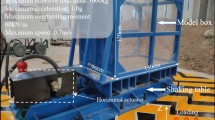Abstract
This paper outlines the seismic vulnerability of rural stone masonry buildings affected by the 2015 Gorkha earthquake sequence. Summary of field observation is presented first and empirical fragility curves are developed from the detailed damage assessment data from 603 villages in central, eastern and western Nepal. Fragility curves are developed on the basis of 665,515 building damage cases collected during the post-earthquake detailed damage assessment campaign conducted by Government of Nepal. Two sets of fragility functions are derived using peak ground acceleration and spectral acceleration at 0.3 s as the intensity measures. The sum of the results highlights that stone masonry buildings in Nepal are highly vulnerable even in the case of low to moderate ground shaking. The results further indicate that in the case of strong to major earthquakes, most of the stone masonry buildings in Nepal would sustain severe damage or collapse.








Similar content being viewed by others
References
Bessason B, Bjarnason JO (2016) Seismic vulnerability of low-rise residential buildings based on damage data from three earthquakes (MW 6.5, 6.5 and 6.3). Eng Struct 111:64–79
Central Bureau of Statistics [CBS] (2012) National population and housing census 2011 (national report). Government of Nepal, Kathmandu
Colombi M, Borzi B, Crowley H, Onida M, Meroni F, Pinho R (2006) Deriving vulnerability curves using Italian earthquake damage data. Bull Earthq Eng 6:485–504
Comerio MC (ed) (2005) PEER testbed study on a laboratory building: exercising seismic performance assessment. PEER Report. PEER 2005/12
Del Gaudio C, De Martino G, De Ludovico M, Manfredi G, Prota A, Ricci P, Verderame GM (2017) Empirical fragility curves from the damage data on RC buildings after the 2009 L’Aquila earthquake. Bull Earthq Eng 15(4):1425–1450
Elnashai A, Di Sarno L (2008) Fundamentals of earthquake engineering. Wiley, London
Gautam D (2017) On seismic fragility of highway bridges in Nepal: 1988 Udaypur earthquake (MW 6.8) revisited. Soil Dyn Earthq Eng 99:168–171
Gautam D, Chaulagain H (2016) Structural performance and associated lessons to be learned from world earthquakes in Nepal after 25 April 2015 (MW 7.8) Gorkha earthquake. Eng Fail Anal 68:222–243
Gautam D, Rodrigues H, Bhetwal KK, Neupane P, Sanada Y (2016) Common structural and construction deficiencies of Nepalese buildings. Innov Infrastruct Solut 1:1. https://doi.org/10.1007/s41062-016-0001-3
Gautam D, Santucci de Magistris F, Fabbrocino G (2017) Soil liquefaction in Kathmandu valley due to 25 April 2015 Gorkha, Nepal earthquake. Soil Dyn Earthq Eng 97:37–47
Grunthal G (1998) European macroseismic scale. European Seismological Commission, Luxembourg
Krawinkler H (ed) (2005) Van Nuys Hotel building testbed report: exercising seismic performance assessment. PEER Report. PEER 2005/11
Lee T-H, Mosalam KM (2006) Probabilistic seismic evaluation of reinforced concrete structural components and systems, PEER Report, PEER 2006/04
Martinelli A, Cifani G, Cialone G, Corazza L, Petracca A (2008) Petrucci G (2008) Building vulnerability assessment and damage scenarios in Celano (Italy) using a quick survey data-based methodology. Soil Dyn Earthq Eng 28:875–889
Moehle JP (2003) A framework for performance-based earthquake engineering. In: Proceedings of the ATC-15-9 workshop on the improvement of building structural design and construction practices, Maui, HI
National Planning Commission Nepal [NPC] (2015) Post disaster need assessment. Government of Nepal, Kathmandu, Nepal
Nepal National Building Code [NBC-105] (1994) Seismic design of buildings in Nepal. Department of Urban Development and Building Construction, Kathmandu, Nepal
Nepal National Building Code [NBC-109] (1994) Masonry: unreinforced. Department of Urban Development and Building Construction, Kathmandu, Nepal
Porter K (2003) An overview of PEER’s performance-based earthquake engineering methodology. In: Proceedings of the 9th international conference on applications of statistics and probability in civil engineering (ICASP9), San Francisco, CA
Porter K, Kennedy R, Bachman R (2007) Creating fragility functions for performance-based earthquake engineering. Earthq Spectra 23(2):471–489
Rossetto T, Elnashai A (2003) Derivation of vulnerability functions for European-type RC structures based on observational data. Eng Struct 25:1241–1263
Rota M, Penna A, Strobbia CL (2008) Processing Italian damage data to derive typological fragility curves. Soil Dyn Earthq Eng 28(10–11):933–947
Rupakhety R, Olafsson O, Halldorsson B (2017) The 2015 MW 7.8 Gorkha earthquake in Nepal and its aftershocks: analysis of strong ground motion. Bull Earthq Eng 15(7):2587–2616
Shinozuka M, Feng MQ, Lee J, Naganuma T (2000) Statistical analysis of fragility curves. J Eng Mech 126(12):1224–1231
United States Geological Survey (2017) M 7.8—36 km E of Khudi, Nepal. https://earthquake.usgs.gov/earthquakes/eventpage/us20002926#executive. Accessed 15 January 2017
Yang TY (2013) Assessing seismic risk for new and existing buildings using performance-based earthquake engineering (PBEE) methodology. In: Tesfamariam S, Goda K (eds) Handbook of seismic risk analysis and management of civil infrastructure systems. Elsevier, Philadelphia, pp 307–333
Acknowledgements
Author would like to express sincere thanks to Steve Wesnousky, Krishna Bhetwal, Pramod Neupane, Liesl Clark, Randolph Langenbach and Krishna Devkota for their kind help during field visit conducted after the Gorkha earthquake. National Reconstruction Authority and Prakriti Sharma are acknowledged for the database and several correspondences. The author would like to acknowledge the two reviewers for the constructive and inspiring comments. Their comments have significantly improved the quality of the manuscript.
Author information
Authors and Affiliations
Corresponding author
Rights and permissions
About this article
Cite this article
Gautam, D. Observational fragility functions for residential stone masonry buildings in Nepal. Bull Earthquake Eng 16, 4661–4673 (2018). https://doi.org/10.1007/s10518-018-0372-2
Received:
Accepted:
Published:
Issue Date:
DOI: https://doi.org/10.1007/s10518-018-0372-2




